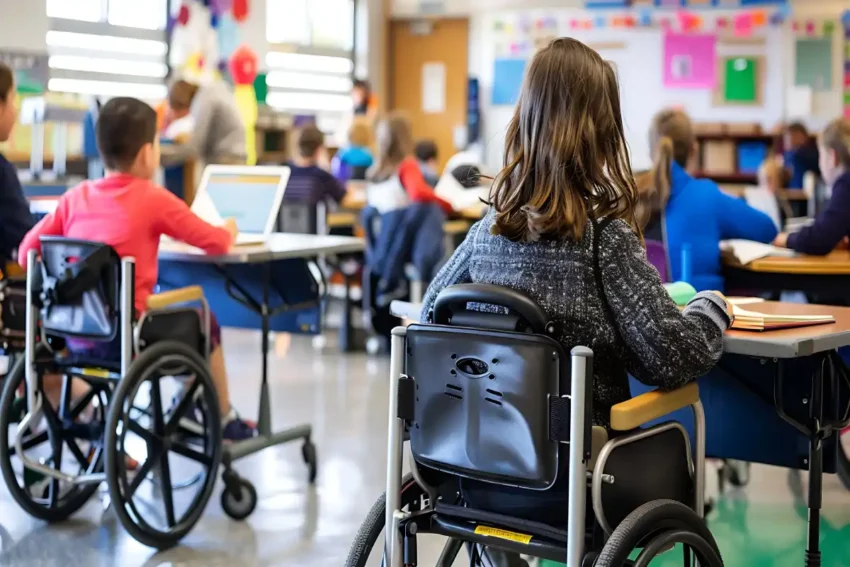Inclusive Classroom Design: Supporting the Rights of Children With Disabilities

Inclusive classrooms continue to reshape how students learn, and the choices you make inside that space can influence how every child experiences the day. When students feel welcomed and understood, they approach learning with more confidence.
Designing a room that supports children with disabilities doesn’t require complicated changes. It simply calls for awareness, intention, and a genuine interest in helping each learner participate comfortably in the learning environment.
Contents
- 1 Creating a Space Where Every Child Feels Considered
- 2 Using Clear Communication To Support Every Learning Style
- 3 Designing Learning Activities That Support Different Strengths
- 4 Using Technology To Improve Access Without Overcomplicating Learning
- 5 Supporting Comfort, Confidence, and Social Connection
- 6 In Conclusion
Creating a Space Where Every Child Feels Considered
An inclusive classroom begins with observing how students interact with their environment. The room’s layout, visual cues, and established routines all affect their comfort level. Clear pathways, structured zones, and simple organization can ease transitions and help students understand where things are and what to expect in the classroom space.
Awareness of general guidelines and legal precedents for special needs students can also guide your decisions. You don’t need an in-depth legal background, but understanding the rights that protect students helps you make informed choices and advocate for appropriate accommodations in special education settings.
As you plan the room, consider a few practical questions. Can students move around without feeling crowded? Do simple visuals support them during routines? Is there a quiet spot available when someone needs a moment? These thoughtful choices contribute to an accessible classroom that feels steady, welcoming, and supportive.
Using Clear Communication To Support Every Learning Style
Students benefit when information is presented in ways that are easy to follow and revisit. Short written cues, picture guides, and visual aids give them reliable reference points throughout the day. These tools reduce confusion and help students move from one activity to the next with less pressure.
When giving directions, keep the steps straightforward. Clear instructions help students focus on the task rather than trying to recall details. This approach supports students who require additional processing time and enhances learning outcomes during lessons.
Regular check-ins strengthen communication as well. Ask simple questions to see if students understood the instructions or if they need another example. These quick conversations encourage honesty and help students feel more comfortable navigating behavioral expectations in class.
Designing Learning Activities That Support Different Strengths
Students learn in different ways, and your activities can reflect that variety. Some respond well to visuals, while others rely on movement, discussion, or hands-on tasks. Offering options supports differentiated instruction and shows students that there’s more than one way to understand a concept.
Sensory-friendly elements can further support learning. Calmer lighting, minimal distractions, or simple organizers can help students stay focused. A child who struggles with written work might respond better to picture-based prompts or visual learning aids, while another might prefer verbal guidance or sign language support.
Group tasks work well when roles are clear and strengths are paired thoughtfully. When students understand how they contribute, they tend to participate more willingly. These moments of collaborative work help them practice communication skills and build a stronger sense of community.
Using Technology To Improve Access Without Overcomplicating Learning
Technology becomes valuable when it makes learning easier to access. Captioned videos, text-to-speech tools, assistive technology, and adjustable displays are practical options that support a range of needs. The goal is to choose tools that simplify learning, rather than introducing additional steps.
Before introducing a new tool, consider how it fits into your lessons. A reading support app, digital checklist, or interactive whiteboards often work better than complex programs. Tools that are easy to learn help students stay focused on instruction rather than the technology.
Give students time to explore tools during low-stress moments. This helps them feel comfortable using them independently. You can also ask for their feedback, since many understand what supports them best when using assistive communication devices that fit their needs.
Supporting Comfort, Confidence, and Social Connection

Emotional comfort plays a major role in how students learn. Predictable routines and steady transitions can help students with disabilities feel more grounded throughout the day. When they understand what comes next, they’re more likely to participate and stay engaged, which supports their growth into resilient students.
Social experiences can be supported through short partner tasks or small-group lessons. When each student has a clear role, interactions feel natural and less intimidating. These structured moments provide students with the opportunity to practice communication and collaborate at their own pace, which fosters positive student perceptions of learning.
Simple check-ins can help students feel seen. Ask if they need a short break or if another example is needed to understand the lesson. These small gestures help the classroom feel more personal and supportive, especially when paired with thoughtful seating arrangements, calming adaptive lighting, or cozy cushioned seats that make the space more comfortable.
In Conclusion
Inclusive classroom design is about understanding what each student needs to learn in order to learn comfortably and confidently. You’re shaping an environment that respects their rights and gives them a place to grow. Clear communication, varied activities, purposeful technology, and emotional support all work together to help students with disabilities feel valued and capable. When you approach inclusion with intention, you create a classroom where every child has a fair chance to participate and succeed.



